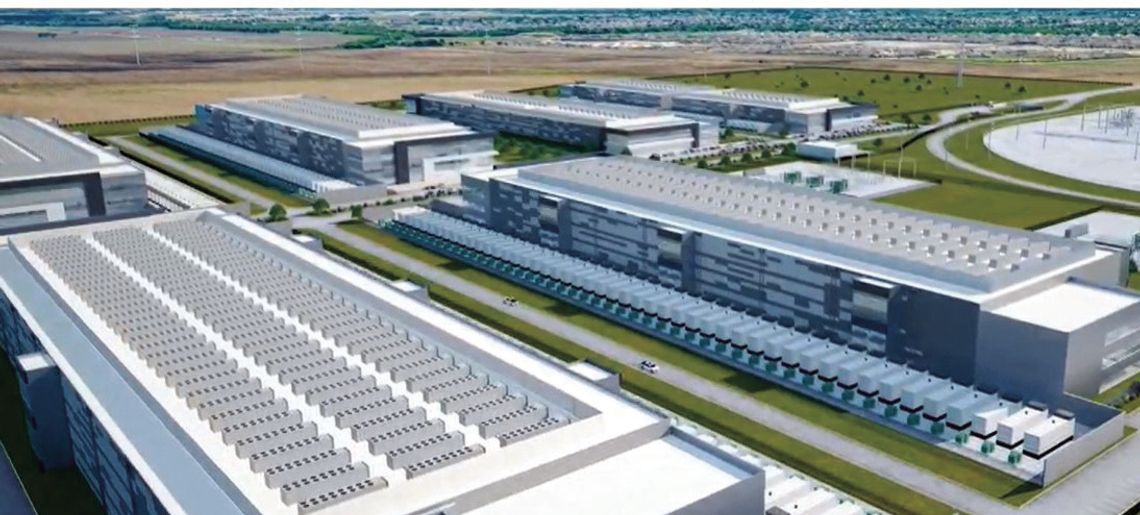Power availability sparks industry boom
HUTTO – Data centers, semiconductor fabrication, light-industrial manufacturing and all the companies that service these enterprises are creating a power corridor along the stretch of U.S. 79 between Round Rock and College Station.
But will the surge of energy-hungry industry lead to a power struggle?
“Look at Milam County and Rockdale, where they announced this summer that a developer bought the 30,000-acre ALCOA facility and out of that they’re carving out 3,200 acres for an advanced manufacturing park which could house 50-million-square feet of industrial space. That’s 20 miles on the other side of Taylor,” Dave Porter, executive director of the Williamson County Economic Development Partnership, told a packed house at the Greater Taylor Chamber of Commerce Gear Up for Growth symposium in April.
“This whole corridor is going to continue to develop, going to continue to attract companies,” Porter said, adding that when he visited South Korea in 2023, representatives from Samsung Austin Semiconductor’s parent company, Samsung Electronics Co. Ltd., told him there are 150 more companies that service Samsung’s chip fabrication that will eventually want to be located within one hour of the plant as it comes online in Taylor.
Those companies are sending out a huge vote of confidence in the region’s availability to provide the power they need, in spite of some recent disasters.
SAMSUNG’S RIPPLES
Samsung announced in fall 2021 it would be injecting billions of dollars into the new 1,200-acre fabrication campus in Taylor, even after its older plant in Austin was offline for several weeks due to power failures in February of that same year.
Winter Storm Uri caused a widespread breakdown of the state electric grid, resulting in billions of dollars of damage and more than 200 deaths. Industry analysts estimate Samsung and other semiconductor fabrication plants in Austin faced hundreds of millions of dollars in losses.
Since then, Texas power plants and transmission providers have winterized their facilities to prevent a recurrence of severe-weather grid failure. And across Williamson County, crews can still be seen replacing wooden electric poles with larger metal poles and higher-capacity lines.
The question remains, though, whether the increase will be enough to power new industry as well as serve the rapidly expanding population?
ERCOTWARNINGS
The Electric Reliability Council of Texas, the agency that manages the flow of Texas’ power supply, has continued to issue appeals to the public in East Williamson County to conserve energy during severe weather. Its Weather Watch notification for Jan 14-17 of this year was issued “due to extreme cold weather across the ERCOT region, higher electrical demand and the potential for lower reserves.”
Similar notifications were issued during last summer’s hottest weeks. More rumblings about the coming summer have also been heard.
ERCOT has a major operations center located in Taylor.
If the power suppliers are even now relying on customers to conserve electricity, where is that energy for the new businesses going to come from?
ONCOR’S ROLE
Skybox Datacenters LLC and Prologis Inc. are ensuring their Skybox Datacenters PowerCampus Austin will have plenty of power through an agreement with Oncor Electric Delivery to build a 600-megawatt substation near their facility at the Hutto Megasite.
“Data centers follow power so as soon as one announced they were building out there, all those data centers started honing in on Hutto,” said Cheney Gamboa, economic development director for the city.
Gamboa announced that PowerCampus Austin would begin operations in 2025, and that a second data center will potentially soon be announced as another Megasite neighbor. The Hutto Economic Development Corp. recently decided to limit any additional applications for data centers to move to the area until they see the impact and are sure there is enough power to support them.
While Gamboa could not divulge any information about the second data center, referring to it as “Project Sequel,” it is rumored to also be another Skybox and Prologis development.
Data centers are the physical embodiment of “the cloud,” acting as centralized hubs for computer data processing, and they require constant and consistent power. An industrial-sized data center uses as much energy as a small town, and PowerCampus Austin will require the ability to run equipment 24/7 without interruption.
Analysts cite the proliferation of artificial intelligence as one reason data centers are a fast-growing industry – AI is data-heavy, and customers expect their data to be available at all times. Additionally, Skybox focuses on working with enterpriselevel clients whose data needs can fill multiple buildings full of servers on the campus once construction is complete.
GOOD BUSINESS
Even with the high energy consumption, Gamboa says data centers are good business.
“The type of campus Skybox is building is air-chilled, not water chillers,” the director said.
She explained data centers are a valuable option for a small town because, while they do use a lot of power, they have relatively few employees and low truck traffic.
“It’s a really low demand on our infrastructure but a huge benefit to our ad valorem (property) taxes,” she added. “That is a great thing for a fast-growing city that is having challenges with infrastructure.”
Gamboa added data centers make large investments in internet connectivity that provide the city and community opportunities for improved bandwidth.
“There have been conversations even on the county level on how to expand (the fiber internet infrastructure) and to benefit some of our more rural communities.

“(A data center is) a really low demand on our infrastructure but a huge benefit to our ad valorem (property) taxes.” — CHENEY GAMBOA ECONOMIC DEVELOPMENT DIRECTOR FOR HUTTO
Trying to think big picture,” the director said.
Though without enough power, that picture could come crashing to the ground. An Oncor spokesman said the company has been experiencing record growth including adding large commercial and industrial customers.
“We have implemented major investments and planning to continue meeting the needs of these new and existing customers. We work hand in hand with local and state partners, from community leaders to ERCOT officials, to review energy and growth needs and incorporate those into longterm infrastructure planning,” engineer Armando Perez wrote in a statement from the company.
He added, “We also work directly with various large-load customers to review their specific potential energy delivery needs and ensure our facilities are prepared to deliver safe and reliable service.”
But substations like the one Oncor is building at the Megasite transmit or distribute power, they don’t create it. Oncor can only work with the electricity it is provided.
A representative for ERCOT said the agency is striving to manage the increased demands on power and has established a task force to identify and help operate new large loads on the grid.
“Texas continues to see significant population growth (and) economic growth including large flexible loads, which adds demand to the grid. Currently, the crypto mining industry represents the largest share of large flexible loads seeking to interconnect to the ERCOT system,” said a statement issued by the agency.
According to EarthJustice, five of the 10 largest U.S. cryptocurrency mining operations are located in Texas, with two of those in nearby Rockdale. In April 2023, the nonprofit environmental law organization reported that Riot Platforms and Bitdeer use 620 megawatts a year between them – more than PowerCampus Austin is projected to use.
CONCERNSREMAIN
ERCOT has made multiple improvements since 2021 to make the grid more reliable and increase energy reserves and resources, but one electrical-supply expert said it still may not be enough.
Joe Gordon is chief engineer and chairman of Frame Switch Energy Inc. The company owns land and has the necessary permits to build a power plant near Frame Switch between Hutto and Taylor, and close to the Megasite.
Gordon sees the grid’s reliance on renewable power sources as a potential for disaster.
“In 2021 (Winter Storm Uri), there weren’t enough generators available, the wind wasn’t blowing, the sun wasn’t showing, there were tens of billions of dollars in damage and people died,” he said. “So the question is, are you going to continue to depend on solar panels and windmills?”
Gordon estimated if the Frame Switch power plant had been online at the time, it may have prevented up to $5 billion in damages. The plant is designed to run on gas or fuel oil, and doesn’t use water.
“We’re not building the plant to run all the time, but to help in high demand or emergency situations to protect the grid,” he said. “When the peaks go high, they would call on us to cover the shortfalls for two or three days until they got things solved.”
He said the plant is at the stage where it can be constructed and provide energy to the grid within just one year, supporting the Taylor and Hutto substations. Gordon said the project is waiting for a client who will pay for the operations so the project can proceed.
Meanwhile, pressure on the grid isn’t letting up. Samsung recently announced that its operations in Taylor would be expanding exponentially. Hutto has several new manufacturing projects lined up. Housing developments are going vertical across the county. And Switch, a company with a portfolio that includes one of the 10 largest data centers in the country, is constructing its fifth Texas campus — a 1.5 millionsquare-foot
expansion into Round Rock.
“There’s more to come. We’re going to continue to invest in this area,” Skybox Chief Development Officer Haynes Strader told the Hutto City Council at a November meeting.
He described the substation Oncor is building to power the Skybox project as one of the most resilient in the country.
“From an electrical standpoint, you’re going to see infrastructure continue to improve,” he said. “None of this works if there’s not power to the building.”








Comment
Comments